Organisational Behaviour: EWS Project Leadership Analysis
VerifiedAdded on 2023/01/23
|10
|2524
|42
Case Study
AI Summary
This case study analysis focuses on Ecological Wastewater Solutions (EWS) and its expansion into the African region, examining the required leadership styles, tools, and techniques for project management. The analysis begins by selecting multicultural leadership to manage the diverse project team, considering the global expansion context. It then explores performance management and coalition building as tools to influence the project team, along with effective communication strategies using various media and models. The study identifies reward, personal, situational, relational, and persuasive power as key motivators for team members. Furthermore, it proposes methods for developing self-managed teams, emphasizing self-driven individuals and interactive workplaces. The report also addresses potential challenges, such as unclear responsibilities and communication issues, and suggests mitigation strategies. The conclusion summarizes the importance of effective project management for EWS's expansion, emphasizing leadership, influence, team motivation, and development.
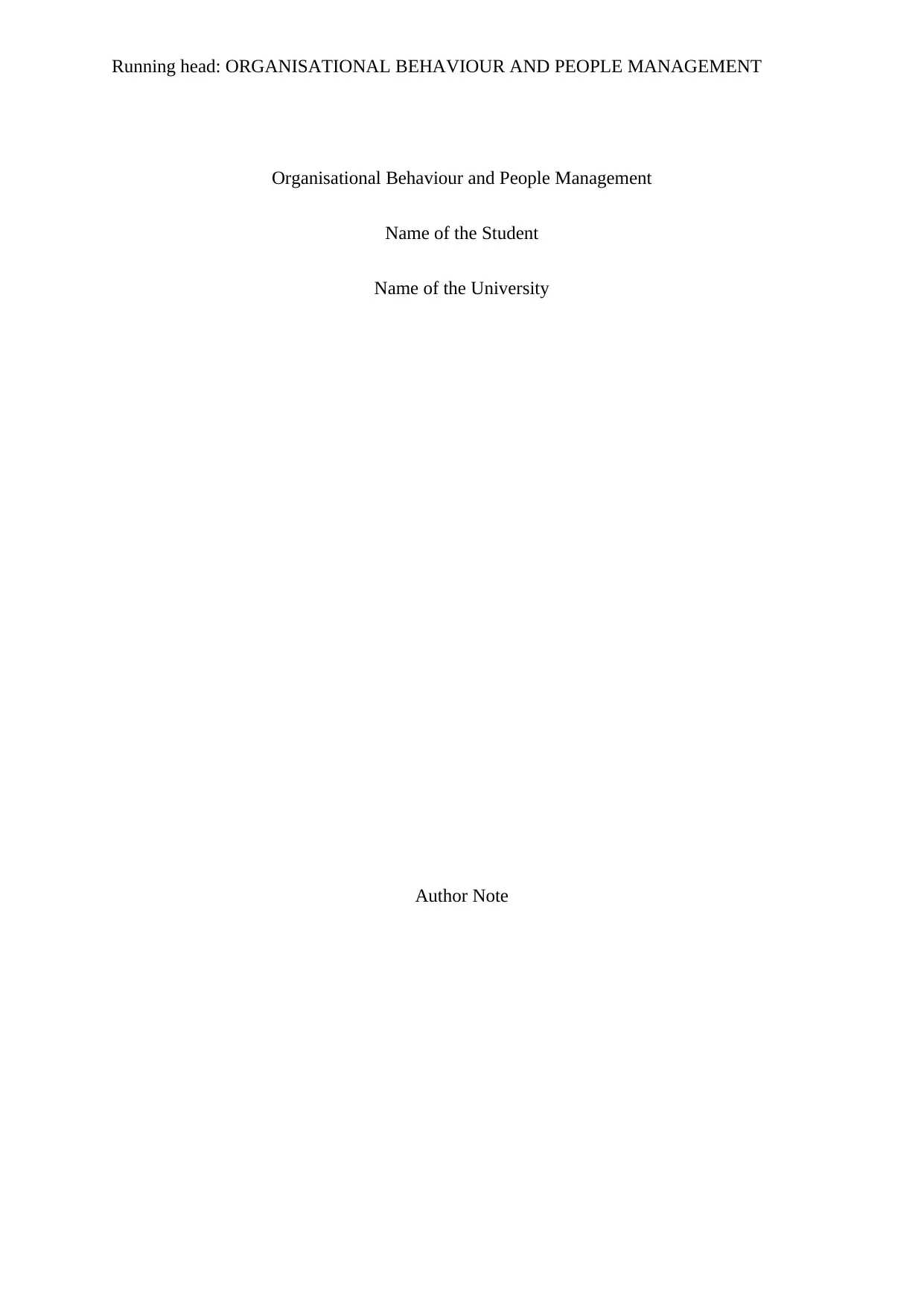
Running head: ORGANISATIONAL BEHAVIOUR AND PEOPLE MANAGEMENT
Organisational Behaviour and People Management
Name of the Student
Name of the University
Author Note
Organisational Behaviour and People Management
Name of the Student
Name of the University
Author Note
Paraphrase This Document
Need a fresh take? Get an instant paraphrase of this document with our AI Paraphraser
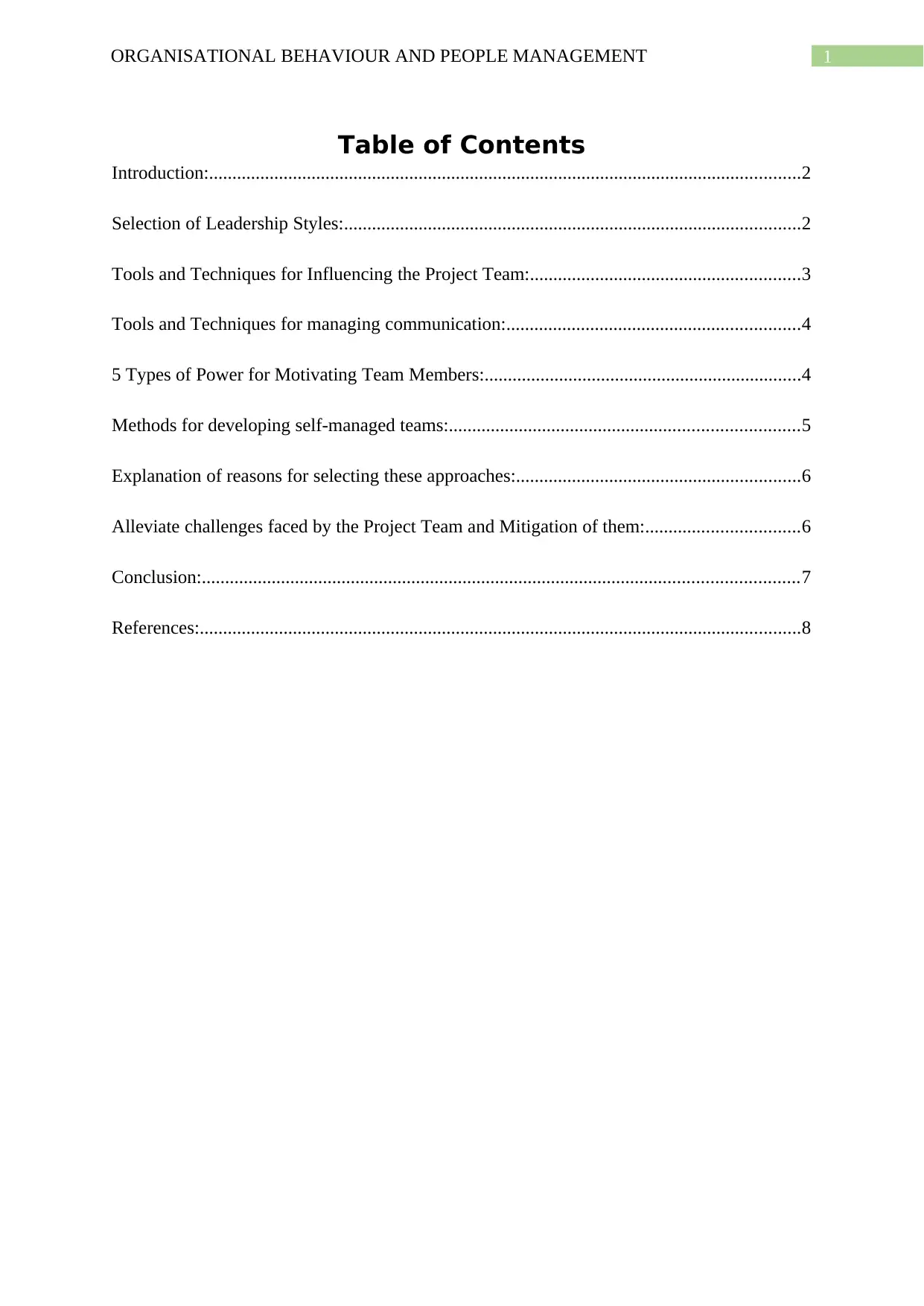
1ORGANISATIONAL BEHAVIOUR AND PEOPLE MANAGEMENT
Table of Contents
Introduction:...............................................................................................................................2
Selection of Leadership Styles:..................................................................................................2
Tools and Techniques for Influencing the Project Team:..........................................................3
Tools and Techniques for managing communication:...............................................................4
5 Types of Power for Motivating Team Members:....................................................................4
Methods for developing self-managed teams:...........................................................................5
Explanation of reasons for selecting these approaches:.............................................................6
Alleviate challenges faced by the Project Team and Mitigation of them:.................................6
Conclusion:................................................................................................................................7
References:.................................................................................................................................8
Table of Contents
Introduction:...............................................................................................................................2
Selection of Leadership Styles:..................................................................................................2
Tools and Techniques for Influencing the Project Team:..........................................................3
Tools and Techniques for managing communication:...............................................................4
5 Types of Power for Motivating Team Members:....................................................................4
Methods for developing self-managed teams:...........................................................................5
Explanation of reasons for selecting these approaches:.............................................................6
Alleviate challenges faced by the Project Team and Mitigation of them:.................................6
Conclusion:................................................................................................................................7
References:.................................................................................................................................8
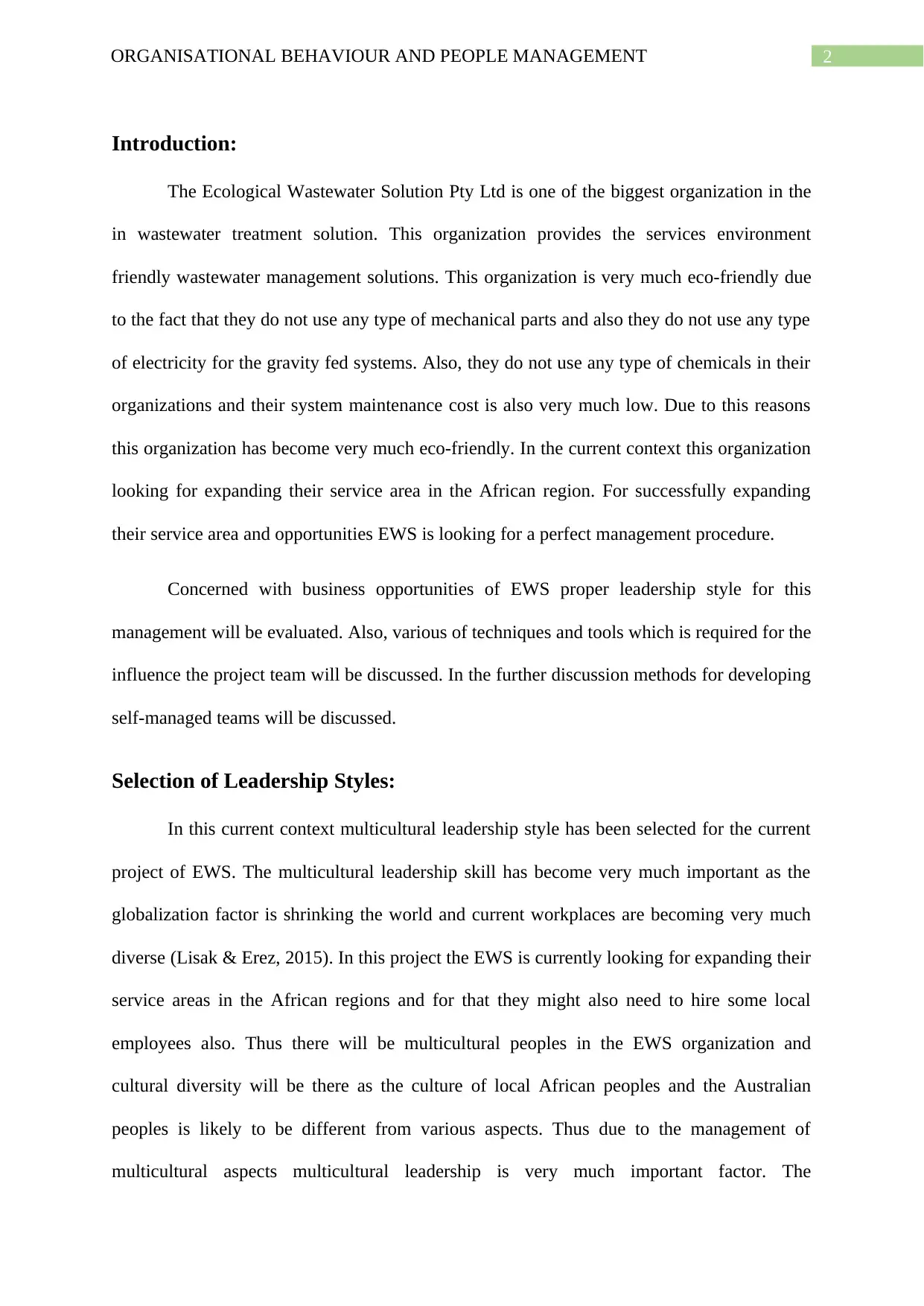
2ORGANISATIONAL BEHAVIOUR AND PEOPLE MANAGEMENT
Introduction:
The Ecological Wastewater Solution Pty Ltd is one of the biggest organization in the
in wastewater treatment solution. This organization provides the services environment
friendly wastewater management solutions. This organization is very much eco-friendly due
to the fact that they do not use any type of mechanical parts and also they do not use any type
of electricity for the gravity fed systems. Also, they do not use any type of chemicals in their
organizations and their system maintenance cost is also very much low. Due to this reasons
this organization has become very much eco-friendly. In the current context this organization
looking for expanding their service area in the African region. For successfully expanding
their service area and opportunities EWS is looking for a perfect management procedure.
Concerned with business opportunities of EWS proper leadership style for this
management will be evaluated. Also, various of techniques and tools which is required for the
influence the project team will be discussed. In the further discussion methods for developing
self-managed teams will be discussed.
Selection of Leadership Styles:
In this current context multicultural leadership style has been selected for the current
project of EWS. The multicultural leadership skill has become very much important as the
globalization factor is shrinking the world and current workplaces are becoming very much
diverse (Lisak & Erez, 2015). In this project the EWS is currently looking for expanding their
service areas in the African regions and for that they might also need to hire some local
employees also. Thus there will be multicultural peoples in the EWS organization and
cultural diversity will be there as the culture of local African peoples and the Australian
peoples is likely to be different from various aspects. Thus due to the management of
multicultural aspects multicultural leadership is very much important factor. The
Introduction:
The Ecological Wastewater Solution Pty Ltd is one of the biggest organization in the
in wastewater treatment solution. This organization provides the services environment
friendly wastewater management solutions. This organization is very much eco-friendly due
to the fact that they do not use any type of mechanical parts and also they do not use any type
of electricity for the gravity fed systems. Also, they do not use any type of chemicals in their
organizations and their system maintenance cost is also very much low. Due to this reasons
this organization has become very much eco-friendly. In the current context this organization
looking for expanding their service area in the African region. For successfully expanding
their service area and opportunities EWS is looking for a perfect management procedure.
Concerned with business opportunities of EWS proper leadership style for this
management will be evaluated. Also, various of techniques and tools which is required for the
influence the project team will be discussed. In the further discussion methods for developing
self-managed teams will be discussed.
Selection of Leadership Styles:
In this current context multicultural leadership style has been selected for the current
project of EWS. The multicultural leadership skill has become very much important as the
globalization factor is shrinking the world and current workplaces are becoming very much
diverse (Lisak & Erez, 2015). In this project the EWS is currently looking for expanding their
service areas in the African regions and for that they might also need to hire some local
employees also. Thus there will be multicultural peoples in the EWS organization and
cultural diversity will be there as the culture of local African peoples and the Australian
peoples is likely to be different from various aspects. Thus due to the management of
multicultural aspects multicultural leadership is very much important factor. The
⊘ This is a preview!⊘
Do you want full access?
Subscribe today to unlock all pages.

Trusted by 1+ million students worldwide
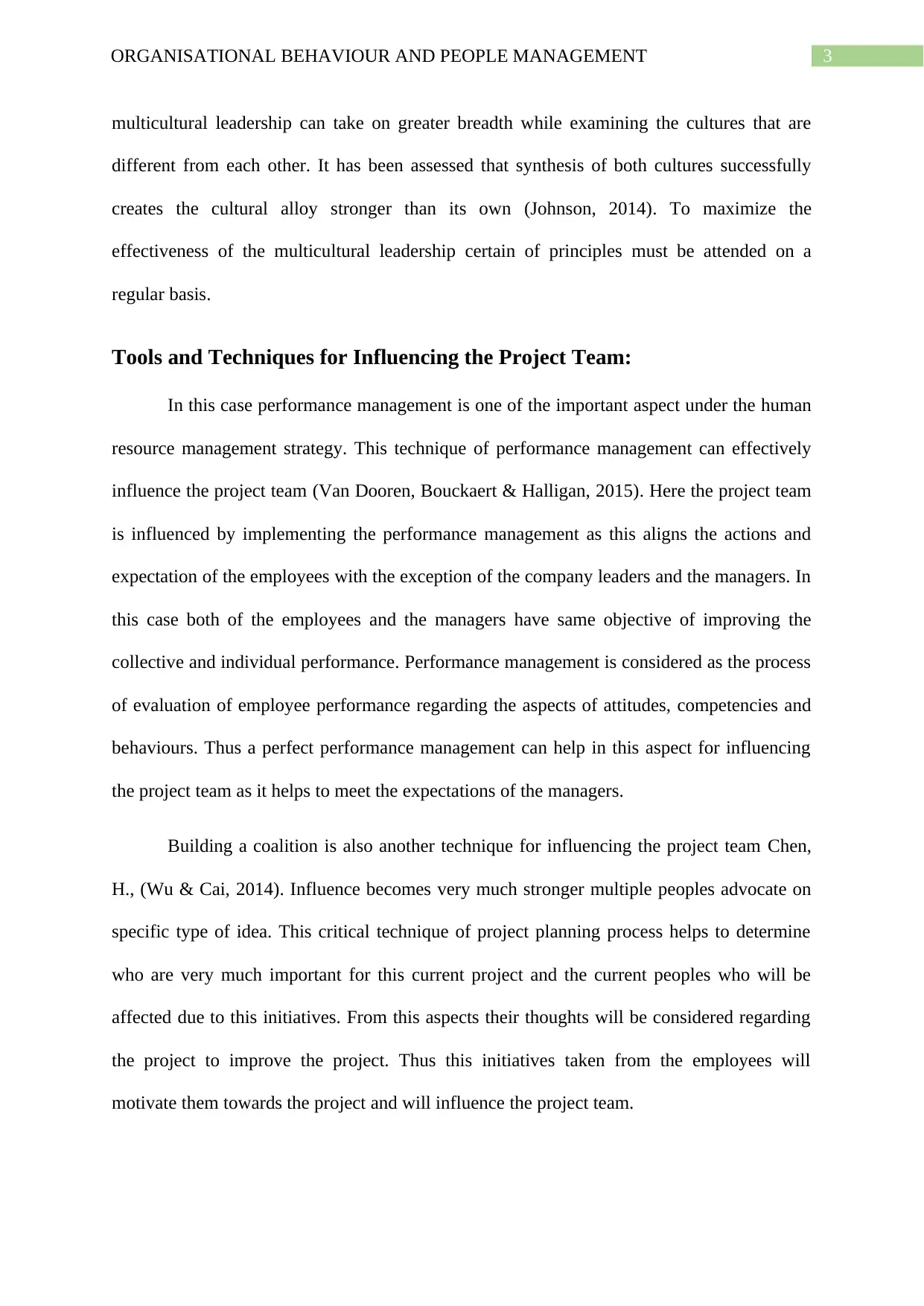
3ORGANISATIONAL BEHAVIOUR AND PEOPLE MANAGEMENT
multicultural leadership can take on greater breadth while examining the cultures that are
different from each other. It has been assessed that synthesis of both cultures successfully
creates the cultural alloy stronger than its own (Johnson, 2014). To maximize the
effectiveness of the multicultural leadership certain of principles must be attended on a
regular basis.
Tools and Techniques for Influencing the Project Team:
In this case performance management is one of the important aspect under the human
resource management strategy. This technique of performance management can effectively
influence the project team (Van Dooren, Bouckaert & Halligan, 2015). Here the project team
is influenced by implementing the performance management as this aligns the actions and
expectation of the employees with the exception of the company leaders and the managers. In
this case both of the employees and the managers have same objective of improving the
collective and individual performance. Performance management is considered as the process
of evaluation of employee performance regarding the aspects of attitudes, competencies and
behaviours. Thus a perfect performance management can help in this aspect for influencing
the project team as it helps to meet the expectations of the managers.
Building a coalition is also another technique for influencing the project team Chen,
H., (Wu & Cai, 2014). Influence becomes very much stronger multiple peoples advocate on
specific type of idea. This critical technique of project planning process helps to determine
who are very much important for this current project and the current peoples who will be
affected due to this initiatives. From this aspects their thoughts will be considered regarding
the project to improve the project. Thus this initiatives taken from the employees will
motivate them towards the project and will influence the project team.
multicultural leadership can take on greater breadth while examining the cultures that are
different from each other. It has been assessed that synthesis of both cultures successfully
creates the cultural alloy stronger than its own (Johnson, 2014). To maximize the
effectiveness of the multicultural leadership certain of principles must be attended on a
regular basis.
Tools and Techniques for Influencing the Project Team:
In this case performance management is one of the important aspect under the human
resource management strategy. This technique of performance management can effectively
influence the project team (Van Dooren, Bouckaert & Halligan, 2015). Here the project team
is influenced by implementing the performance management as this aligns the actions and
expectation of the employees with the exception of the company leaders and the managers. In
this case both of the employees and the managers have same objective of improving the
collective and individual performance. Performance management is considered as the process
of evaluation of employee performance regarding the aspects of attitudes, competencies and
behaviours. Thus a perfect performance management can help in this aspect for influencing
the project team as it helps to meet the expectations of the managers.
Building a coalition is also another technique for influencing the project team Chen,
H., (Wu & Cai, 2014). Influence becomes very much stronger multiple peoples advocate on
specific type of idea. This critical technique of project planning process helps to determine
who are very much important for this current project and the current peoples who will be
affected due to this initiatives. From this aspects their thoughts will be considered regarding
the project to improve the project. Thus this initiatives taken from the employees will
motivate them towards the project and will influence the project team.
Paraphrase This Document
Need a fresh take? Get an instant paraphrase of this document with our AI Paraphraser
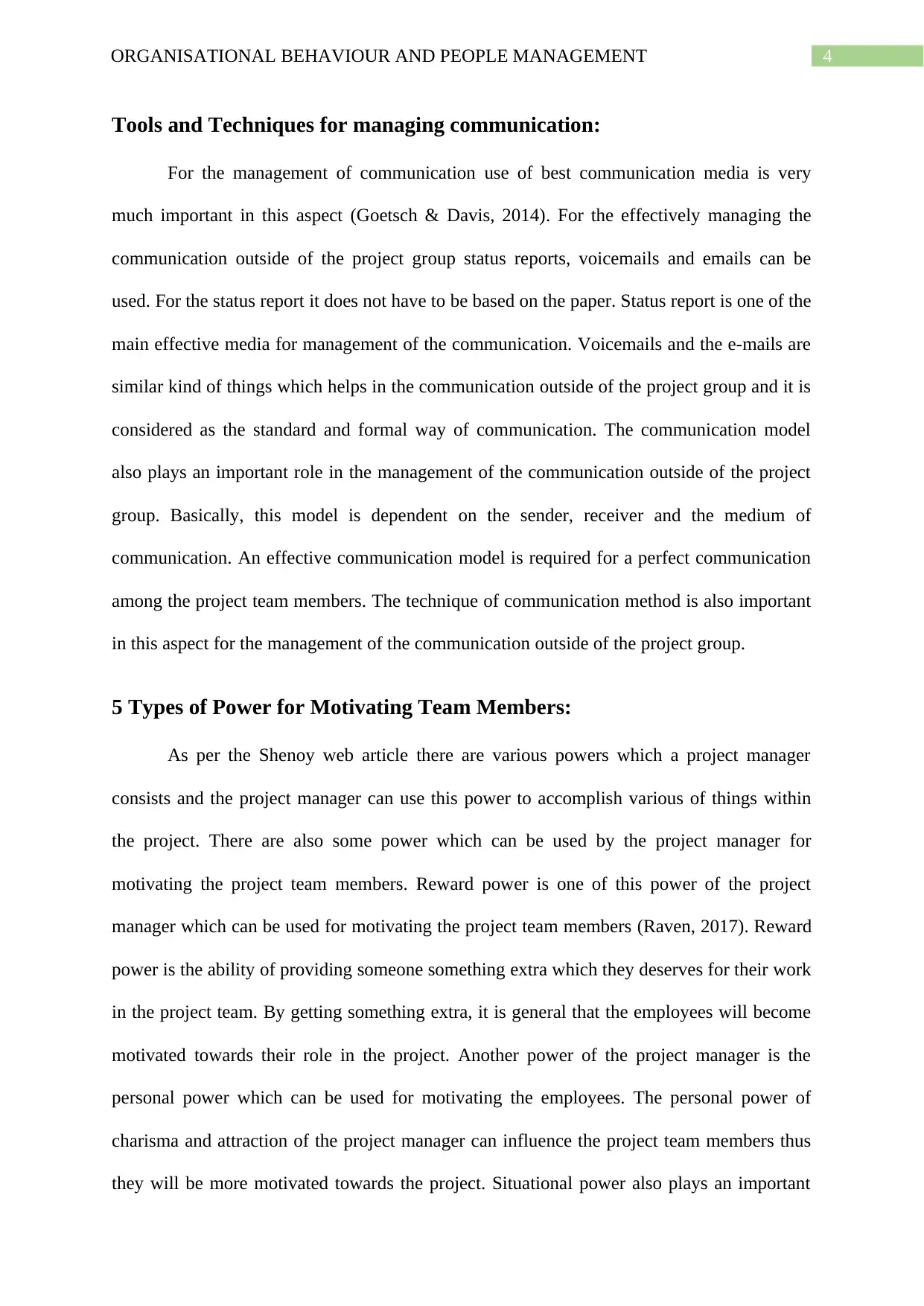
4ORGANISATIONAL BEHAVIOUR AND PEOPLE MANAGEMENT
Tools and Techniques for managing communication:
For the management of communication use of best communication media is very
much important in this aspect (Goetsch & Davis, 2014). For the effectively managing the
communication outside of the project group status reports, voicemails and emails can be
used. For the status report it does not have to be based on the paper. Status report is one of the
main effective media for management of the communication. Voicemails and the e-mails are
similar kind of things which helps in the communication outside of the project group and it is
considered as the standard and formal way of communication. The communication model
also plays an important role in the management of the communication outside of the project
group. Basically, this model is dependent on the sender, receiver and the medium of
communication. An effective communication model is required for a perfect communication
among the project team members. The technique of communication method is also important
in this aspect for the management of the communication outside of the project group.
5 Types of Power for Motivating Team Members:
As per the Shenoy web article there are various powers which a project manager
consists and the project manager can use this power to accomplish various of things within
the project. There are also some power which can be used by the project manager for
motivating the project team members. Reward power is one of this power of the project
manager which can be used for motivating the project team members (Raven, 2017). Reward
power is the ability of providing someone something extra which they deserves for their work
in the project team. By getting something extra, it is general that the employees will become
motivated towards their role in the project. Another power of the project manager is the
personal power which can be used for motivating the employees. The personal power of
charisma and attraction of the project manager can influence the project team members thus
they will be more motivated towards the project. Situational power also plays an important
Tools and Techniques for managing communication:
For the management of communication use of best communication media is very
much important in this aspect (Goetsch & Davis, 2014). For the effectively managing the
communication outside of the project group status reports, voicemails and emails can be
used. For the status report it does not have to be based on the paper. Status report is one of the
main effective media for management of the communication. Voicemails and the e-mails are
similar kind of things which helps in the communication outside of the project group and it is
considered as the standard and formal way of communication. The communication model
also plays an important role in the management of the communication outside of the project
group. Basically, this model is dependent on the sender, receiver and the medium of
communication. An effective communication model is required for a perfect communication
among the project team members. The technique of communication method is also important
in this aspect for the management of the communication outside of the project group.
5 Types of Power for Motivating Team Members:
As per the Shenoy web article there are various powers which a project manager
consists and the project manager can use this power to accomplish various of things within
the project. There are also some power which can be used by the project manager for
motivating the project team members. Reward power is one of this power of the project
manager which can be used for motivating the project team members (Raven, 2017). Reward
power is the ability of providing someone something extra which they deserves for their work
in the project team. By getting something extra, it is general that the employees will become
motivated towards their role in the project. Another power of the project manager is the
personal power which can be used for motivating the employees. The personal power of
charisma and attraction of the project manager can influence the project team members thus
they will be more motivated towards the project. Situational power also plays an important
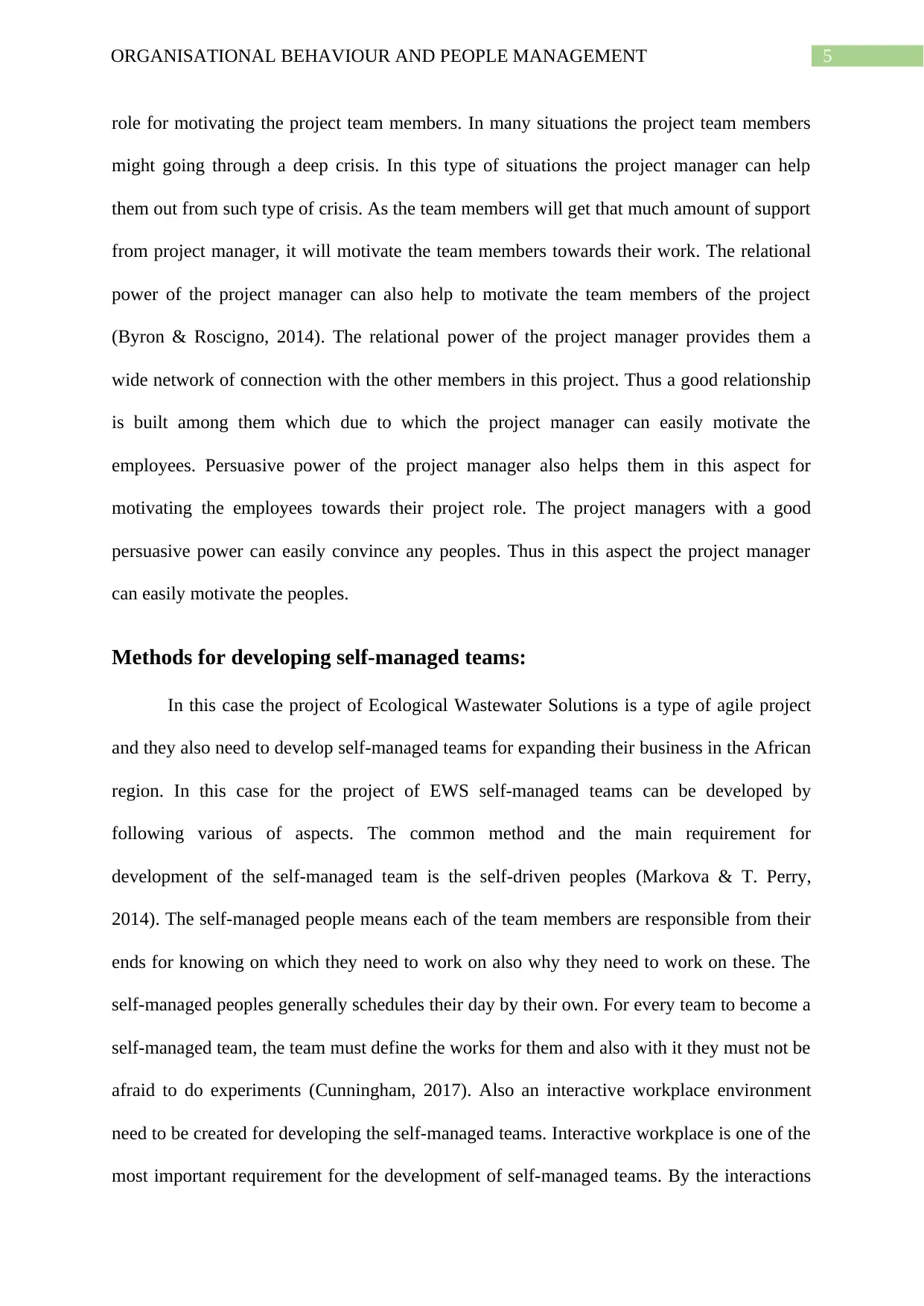
5ORGANISATIONAL BEHAVIOUR AND PEOPLE MANAGEMENT
role for motivating the project team members. In many situations the project team members
might going through a deep crisis. In this type of situations the project manager can help
them out from such type of crisis. As the team members will get that much amount of support
from project manager, it will motivate the team members towards their work. The relational
power of the project manager can also help to motivate the team members of the project
(Byron & Roscigno, 2014). The relational power of the project manager provides them a
wide network of connection with the other members in this project. Thus a good relationship
is built among them which due to which the project manager can easily motivate the
employees. Persuasive power of the project manager also helps them in this aspect for
motivating the employees towards their project role. The project managers with a good
persuasive power can easily convince any peoples. Thus in this aspect the project manager
can easily motivate the peoples.
Methods for developing self-managed teams:
In this case the project of Ecological Wastewater Solutions is a type of agile project
and they also need to develop self-managed teams for expanding their business in the African
region. In this case for the project of EWS self-managed teams can be developed by
following various of aspects. The common method and the main requirement for
development of the self-managed team is the self-driven peoples (Markova & T. Perry,
2014). The self-managed people means each of the team members are responsible from their
ends for knowing on which they need to work on also why they need to work on these. The
self-managed peoples generally schedules their day by their own. For every team to become a
self-managed team, the team must define the works for them and also with it they must not be
afraid to do experiments (Cunningham, 2017). Also an interactive workplace environment
need to be created for developing the self-managed teams. Interactive workplace is one of the
most important requirement for the development of self-managed teams. By the interactions
role for motivating the project team members. In many situations the project team members
might going through a deep crisis. In this type of situations the project manager can help
them out from such type of crisis. As the team members will get that much amount of support
from project manager, it will motivate the team members towards their work. The relational
power of the project manager can also help to motivate the team members of the project
(Byron & Roscigno, 2014). The relational power of the project manager provides them a
wide network of connection with the other members in this project. Thus a good relationship
is built among them which due to which the project manager can easily motivate the
employees. Persuasive power of the project manager also helps them in this aspect for
motivating the employees towards their project role. The project managers with a good
persuasive power can easily convince any peoples. Thus in this aspect the project manager
can easily motivate the peoples.
Methods for developing self-managed teams:
In this case the project of Ecological Wastewater Solutions is a type of agile project
and they also need to develop self-managed teams for expanding their business in the African
region. In this case for the project of EWS self-managed teams can be developed by
following various of aspects. The common method and the main requirement for
development of the self-managed team is the self-driven peoples (Markova & T. Perry,
2014). The self-managed people means each of the team members are responsible from their
ends for knowing on which they need to work on also why they need to work on these. The
self-managed peoples generally schedules their day by their own. For every team to become a
self-managed team, the team must define the works for them and also with it they must not be
afraid to do experiments (Cunningham, 2017). Also an interactive workplace environment
need to be created for developing the self-managed teams. Interactive workplace is one of the
most important requirement for the development of self-managed teams. By the interactions
⊘ This is a preview!⊘
Do you want full access?
Subscribe today to unlock all pages.

Trusted by 1+ million students worldwide
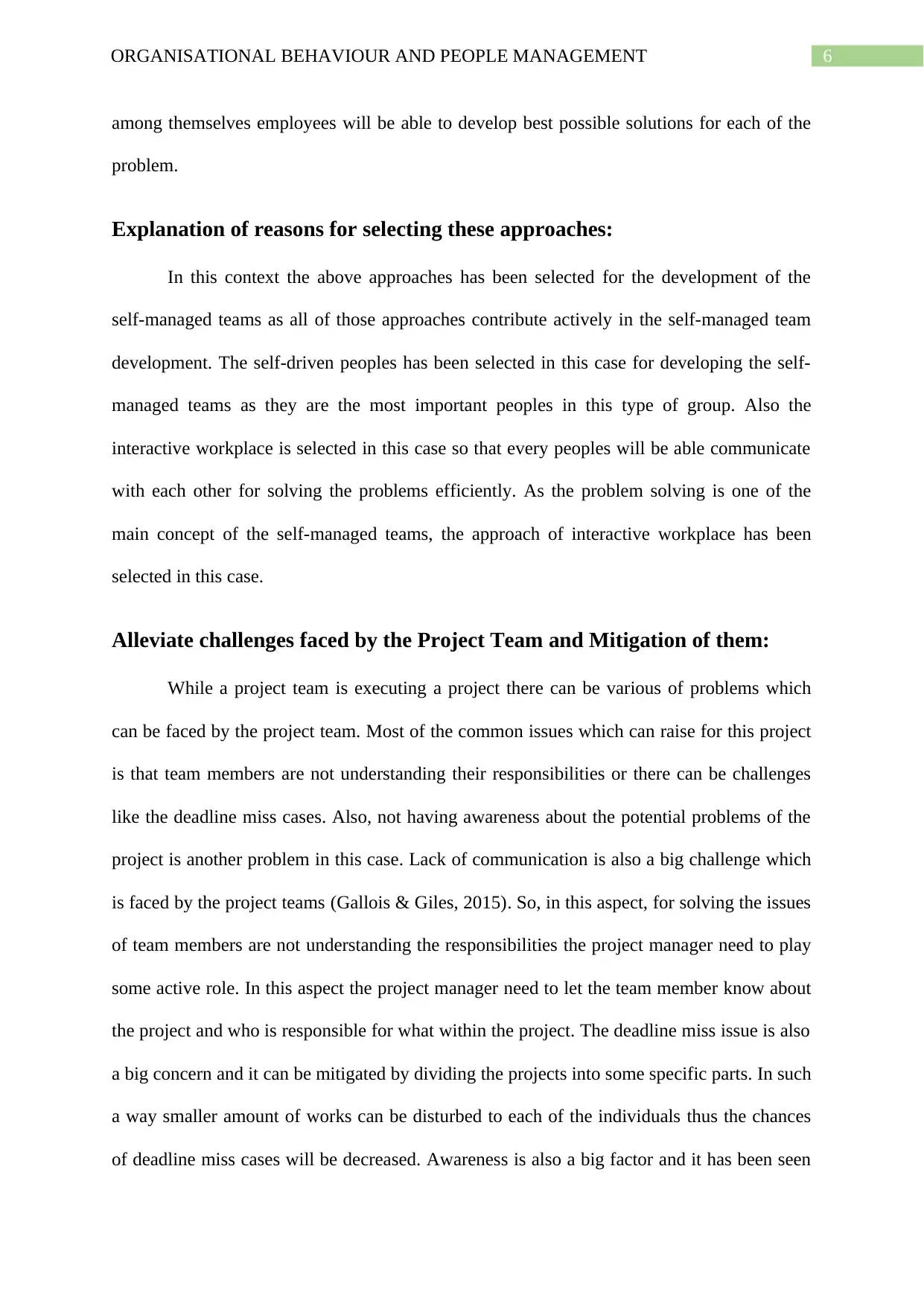
6ORGANISATIONAL BEHAVIOUR AND PEOPLE MANAGEMENT
among themselves employees will be able to develop best possible solutions for each of the
problem.
Explanation of reasons for selecting these approaches:
In this context the above approaches has been selected for the development of the
self-managed teams as all of those approaches contribute actively in the self-managed team
development. The self-driven peoples has been selected in this case for developing the self-
managed teams as they are the most important peoples in this type of group. Also the
interactive workplace is selected in this case so that every peoples will be able communicate
with each other for solving the problems efficiently. As the problem solving is one of the
main concept of the self-managed teams, the approach of interactive workplace has been
selected in this case.
Alleviate challenges faced by the Project Team and Mitigation of them:
While a project team is executing a project there can be various of problems which
can be faced by the project team. Most of the common issues which can raise for this project
is that team members are not understanding their responsibilities or there can be challenges
like the deadline miss cases. Also, not having awareness about the potential problems of the
project is another problem in this case. Lack of communication is also a big challenge which
is faced by the project teams (Gallois & Giles, 2015). So, in this aspect, for solving the issues
of team members are not understanding the responsibilities the project manager need to play
some active role. In this aspect the project manager need to let the team member know about
the project and who is responsible for what within the project. The deadline miss issue is also
a big concern and it can be mitigated by dividing the projects into some specific parts. In such
a way smaller amount of works can be disturbed to each of the individuals thus the chances
of deadline miss cases will be decreased. Awareness is also a big factor and it has been seen
among themselves employees will be able to develop best possible solutions for each of the
problem.
Explanation of reasons for selecting these approaches:
In this context the above approaches has been selected for the development of the
self-managed teams as all of those approaches contribute actively in the self-managed team
development. The self-driven peoples has been selected in this case for developing the self-
managed teams as they are the most important peoples in this type of group. Also the
interactive workplace is selected in this case so that every peoples will be able communicate
with each other for solving the problems efficiently. As the problem solving is one of the
main concept of the self-managed teams, the approach of interactive workplace has been
selected in this case.
Alleviate challenges faced by the Project Team and Mitigation of them:
While a project team is executing a project there can be various of problems which
can be faced by the project team. Most of the common issues which can raise for this project
is that team members are not understanding their responsibilities or there can be challenges
like the deadline miss cases. Also, not having awareness about the potential problems of the
project is another problem in this case. Lack of communication is also a big challenge which
is faced by the project teams (Gallois & Giles, 2015). So, in this aspect, for solving the issues
of team members are not understanding the responsibilities the project manager need to play
some active role. In this aspect the project manager need to let the team member know about
the project and who is responsible for what within the project. The deadline miss issue is also
a big concern and it can be mitigated by dividing the projects into some specific parts. In such
a way smaller amount of works can be disturbed to each of the individuals thus the chances
of deadline miss cases will be decreased. Awareness is also a big factor and it has been seen
Paraphrase This Document
Need a fresh take? Get an instant paraphrase of this document with our AI Paraphraser
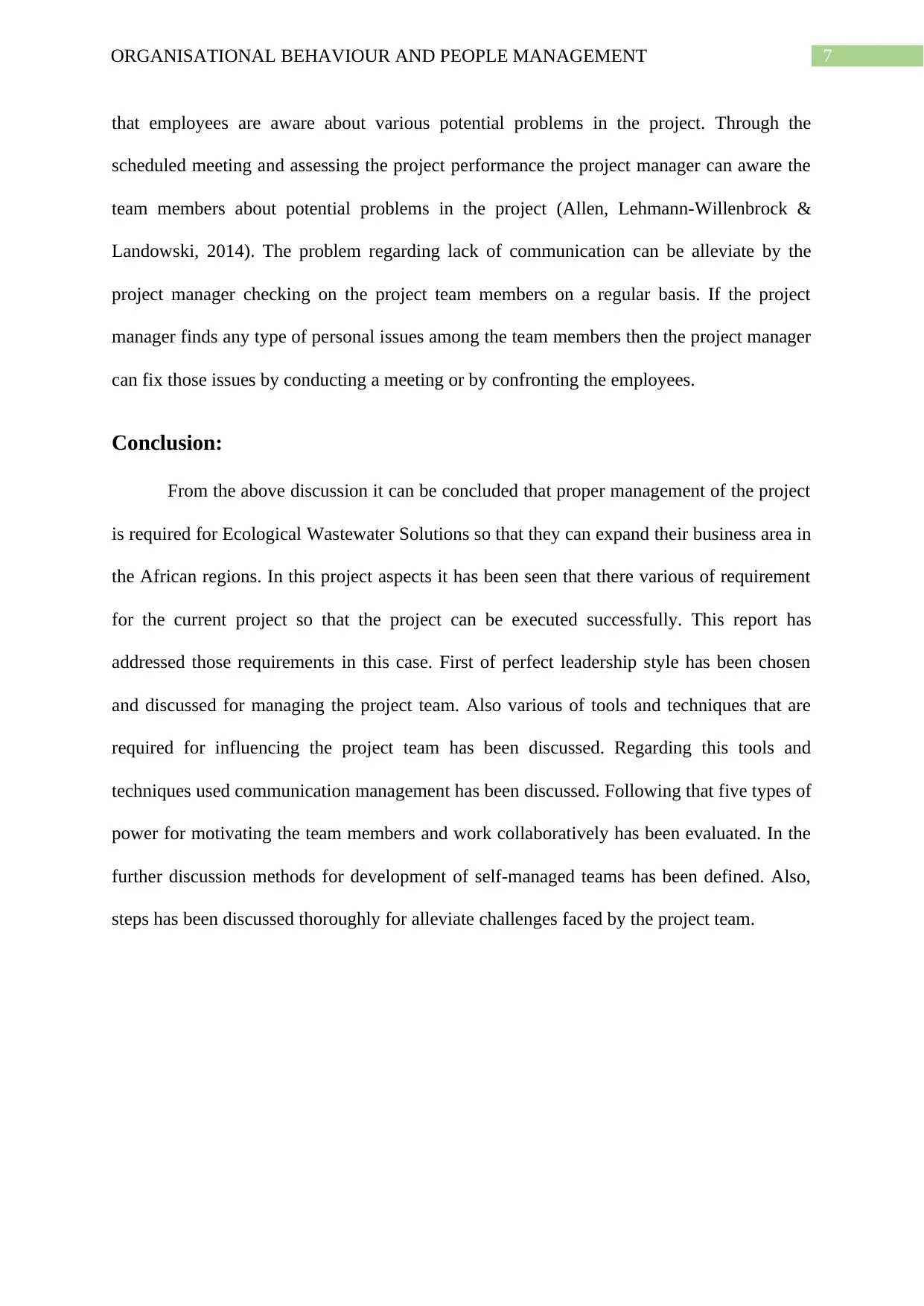
7ORGANISATIONAL BEHAVIOUR AND PEOPLE MANAGEMENT
that employees are aware about various potential problems in the project. Through the
scheduled meeting and assessing the project performance the project manager can aware the
team members about potential problems in the project (Allen, Lehmann-Willenbrock &
Landowski, 2014). The problem regarding lack of communication can be alleviate by the
project manager checking on the project team members on a regular basis. If the project
manager finds any type of personal issues among the team members then the project manager
can fix those issues by conducting a meeting or by confronting the employees.
Conclusion:
From the above discussion it can be concluded that proper management of the project
is required for Ecological Wastewater Solutions so that they can expand their business area in
the African regions. In this project aspects it has been seen that there various of requirement
for the current project so that the project can be executed successfully. This report has
addressed those requirements in this case. First of perfect leadership style has been chosen
and discussed for managing the project team. Also various of tools and techniques that are
required for influencing the project team has been discussed. Regarding this tools and
techniques used communication management has been discussed. Following that five types of
power for motivating the team members and work collaboratively has been evaluated. In the
further discussion methods for development of self-managed teams has been defined. Also,
steps has been discussed thoroughly for alleviate challenges faced by the project team.
that employees are aware about various potential problems in the project. Through the
scheduled meeting and assessing the project performance the project manager can aware the
team members about potential problems in the project (Allen, Lehmann-Willenbrock &
Landowski, 2014). The problem regarding lack of communication can be alleviate by the
project manager checking on the project team members on a regular basis. If the project
manager finds any type of personal issues among the team members then the project manager
can fix those issues by conducting a meeting or by confronting the employees.
Conclusion:
From the above discussion it can be concluded that proper management of the project
is required for Ecological Wastewater Solutions so that they can expand their business area in
the African regions. In this project aspects it has been seen that there various of requirement
for the current project so that the project can be executed successfully. This report has
addressed those requirements in this case. First of perfect leadership style has been chosen
and discussed for managing the project team. Also various of tools and techniques that are
required for influencing the project team has been discussed. Regarding this tools and
techniques used communication management has been discussed. Following that five types of
power for motivating the team members and work collaboratively has been evaluated. In the
further discussion methods for development of self-managed teams has been defined. Also,
steps has been discussed thoroughly for alleviate challenges faced by the project team.
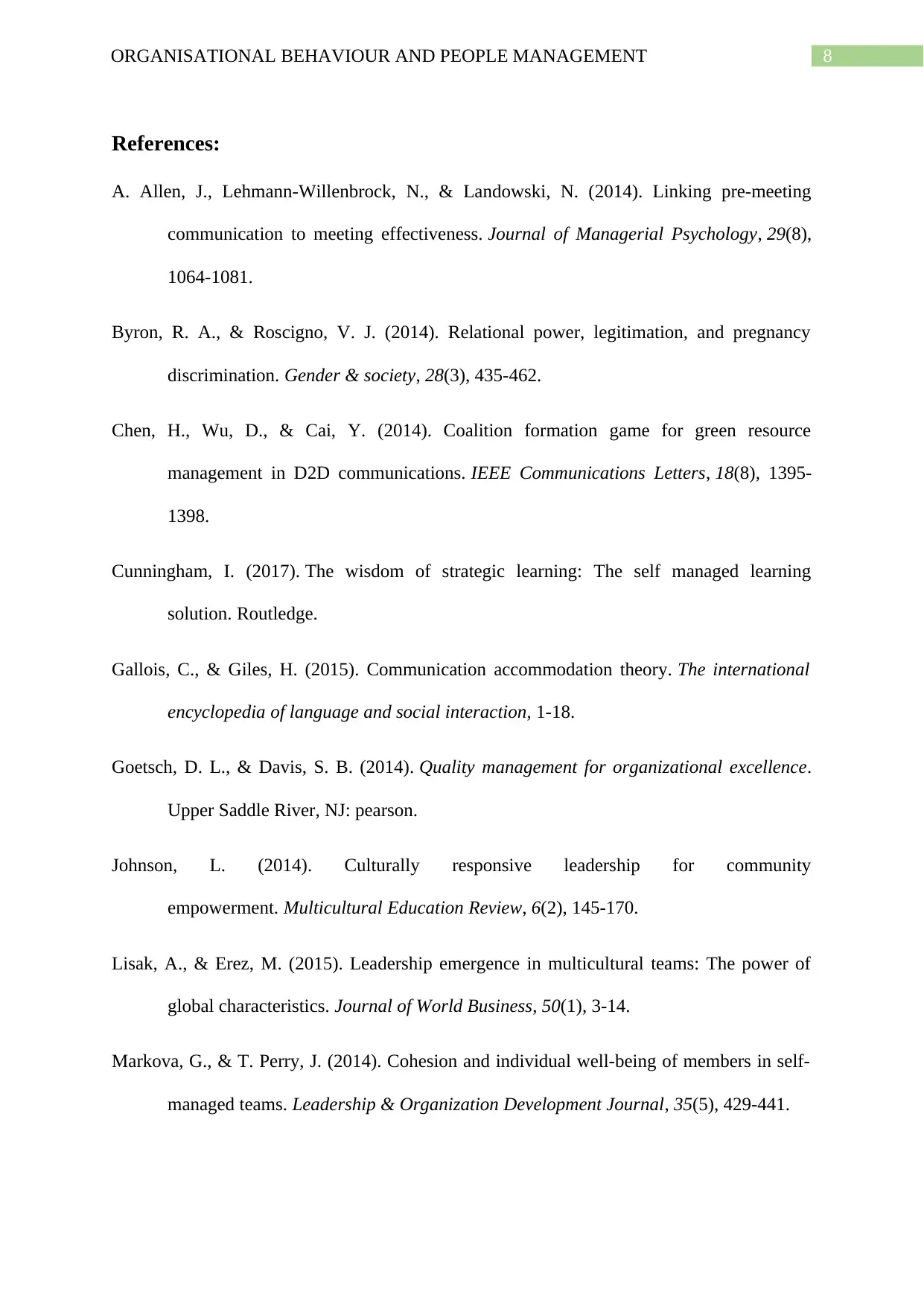
8ORGANISATIONAL BEHAVIOUR AND PEOPLE MANAGEMENT
References:
A. Allen, J., Lehmann-Willenbrock, N., & Landowski, N. (2014). Linking pre-meeting
communication to meeting effectiveness. Journal of Managerial Psychology, 29(8),
1064-1081.
Byron, R. A., & Roscigno, V. J. (2014). Relational power, legitimation, and pregnancy
discrimination. Gender & society, 28(3), 435-462.
Chen, H., Wu, D., & Cai, Y. (2014). Coalition formation game for green resource
management in D2D communications. IEEE Communications Letters, 18(8), 1395-
1398.
Cunningham, I. (2017). The wisdom of strategic learning: The self managed learning
solution. Routledge.
Gallois, C., & Giles, H. (2015). Communication accommodation theory. The international
encyclopedia of language and social interaction, 1-18.
Goetsch, D. L., & Davis, S. B. (2014). Quality management for organizational excellence.
Upper Saddle River, NJ: pearson.
Johnson, L. (2014). Culturally responsive leadership for community
empowerment. Multicultural Education Review, 6(2), 145-170.
Lisak, A., & Erez, M. (2015). Leadership emergence in multicultural teams: The power of
global characteristics. Journal of World Business, 50(1), 3-14.
Markova, G., & T. Perry, J. (2014). Cohesion and individual well-being of members in self-
managed teams. Leadership & Organization Development Journal, 35(5), 429-441.
References:
A. Allen, J., Lehmann-Willenbrock, N., & Landowski, N. (2014). Linking pre-meeting
communication to meeting effectiveness. Journal of Managerial Psychology, 29(8),
1064-1081.
Byron, R. A., & Roscigno, V. J. (2014). Relational power, legitimation, and pregnancy
discrimination. Gender & society, 28(3), 435-462.
Chen, H., Wu, D., & Cai, Y. (2014). Coalition formation game for green resource
management in D2D communications. IEEE Communications Letters, 18(8), 1395-
1398.
Cunningham, I. (2017). The wisdom of strategic learning: The self managed learning
solution. Routledge.
Gallois, C., & Giles, H. (2015). Communication accommodation theory. The international
encyclopedia of language and social interaction, 1-18.
Goetsch, D. L., & Davis, S. B. (2014). Quality management for organizational excellence.
Upper Saddle River, NJ: pearson.
Johnson, L. (2014). Culturally responsive leadership for community
empowerment. Multicultural Education Review, 6(2), 145-170.
Lisak, A., & Erez, M. (2015). Leadership emergence in multicultural teams: The power of
global characteristics. Journal of World Business, 50(1), 3-14.
Markova, G., & T. Perry, J. (2014). Cohesion and individual well-being of members in self-
managed teams. Leadership & Organization Development Journal, 35(5), 429-441.
⊘ This is a preview!⊘
Do you want full access?
Subscribe today to unlock all pages.

Trusted by 1+ million students worldwide
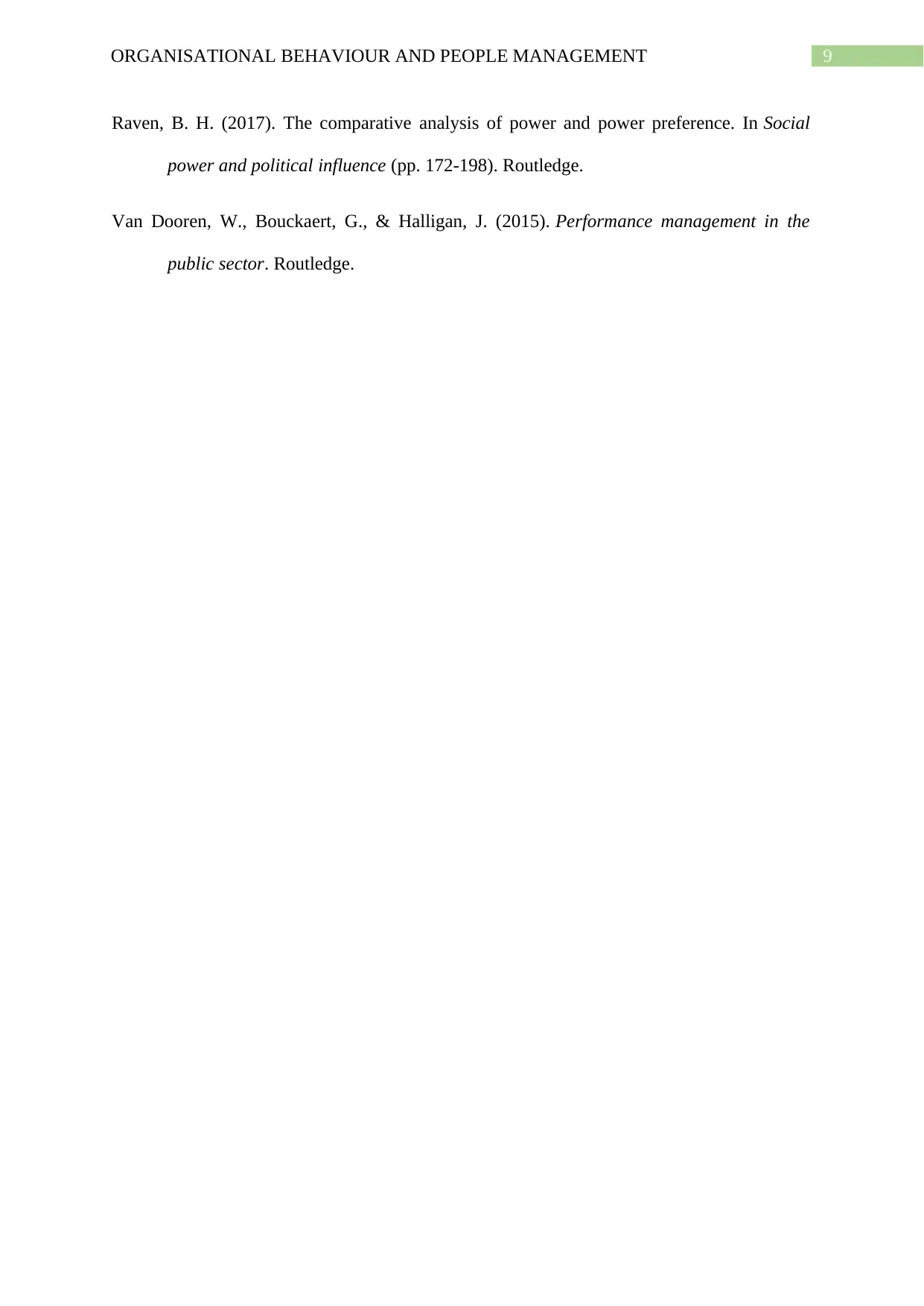
9ORGANISATIONAL BEHAVIOUR AND PEOPLE MANAGEMENT
Raven, B. H. (2017). The comparative analysis of power and power preference. In Social
power and political influence (pp. 172-198). Routledge.
Van Dooren, W., Bouckaert, G., & Halligan, J. (2015). Performance management in the
public sector. Routledge.
Raven, B. H. (2017). The comparative analysis of power and power preference. In Social
power and political influence (pp. 172-198). Routledge.
Van Dooren, W., Bouckaert, G., & Halligan, J. (2015). Performance management in the
public sector. Routledge.
1 out of 10
Related Documents
Your All-in-One AI-Powered Toolkit for Academic Success.
+13062052269
info@desklib.com
Available 24*7 on WhatsApp / Email
![[object Object]](/_next/static/media/star-bottom.7253800d.svg)
Unlock your academic potential
Copyright © 2020–2025 A2Z Services. All Rights Reserved. Developed and managed by ZUCOL.





